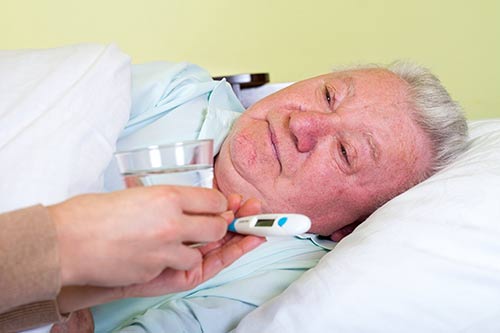Some of the prevalent nursing home infections worth mentioning include:
- Influenza
- Urinary tract infections
- Soft tissue infections
- Antimicrobial-resistant bacteria
- Diarrheal diseases
- Respiratory infections
Let’s look over some of the nursing home infections mentioned above:
Respiratory Tract Infections
These outbreaks can be derived from residents with reactivation tuberculosis and nonresidents, visitors, or staff suffering from an acute respiratory infection. Upon gaining entry into the nursing home, respiratory pathogens usually disperse rapidly among staff and residents. They may spread through indirect or direct contact, large respiratory droplets, or airborne droplet nuclei. Respiratory tract infections are the most frequent cause of mortality in nursing home residents.
Urinary Tract Infection
This is the most prevalent infection in nursing homes. The risk of contracting both bacteriuria and UTIs significantly increases with the existence of an indwelling urinary catheter. For instance, an estimated 3-7% of nursing home residents with an indwelling urinary catheter will contract a UTI every day the catheter is in place. 30 days following catheter insertion, the widespread presence of bacteriuria will be almost 100%. It’s approximated that 50% of nursing home residents having a urinary catheter are likely to contract UTIs.
Diarrheal Diseases
Diarrheal diseases in nursing homes are primarily caused by bacterial and viral gastroenteritis. Elder folk have decreased gastric acid production and are therefore more susceptible to contracting infectious gastroenteritis. Gastroenteritis in older nursing home residents is linked with increased mortality and morbidity, largely because of a higher dehydration risk.
Soft Tissue Infections
Older residents in nursing homes are particularly vulnerable to soft tissue and skin infections because of multiple physiologic alterations that happen with aging, including extended wound healing, atrophy of dermis and epidermis, and decreased resistance to exterior insults. Dry, itchy skin can serve as a gateway for pathogen entry. Nursing homes bacterial infections include necrotizing fasciitis, erysipelas, and cellulitis.
On the other end, chronic wound infections include vascular ulcers, diabetic wound infections, and pressure ulcers. Other infections include tinea Versicolor, intertrigo, viral skin infections like scabies, simplex, and herpes zoster.



